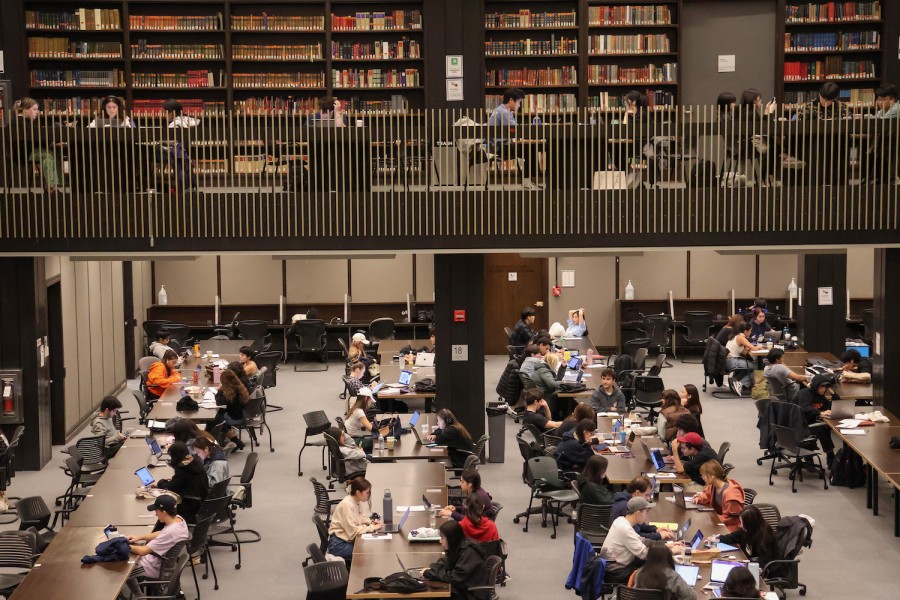Opinion: For a building so big, Bobst has little seating room
More than four million volumes, 53,320 serial titles, 43,000 linear feet of archives, and yet there’s little room for students in Bobst Library.
(Yuna Baek for WSN)
March 6, 2023
If it isn’t the excessive heat or stench of body odor that prevents you from stepping foot into Bobst Library, then perhaps it’s the lack of seating.
Thanks to the donation of $6 million from Elmer Holmes Bobst, the library opened its doors on Sept. 12, 1973. Standing tall with 12 above-ground stories, two below-ground levels and a sub-basement level for maintenance, the library measures to be 425,000 square feet. Despite this enormous size and capacity, Bobst fails to have the most basic amenity for its visitors: seats.
The library receives 10,000 visits per day. This includes not only NYU students, but also those attending the New School, Cooper Union and Columbia University, as well as researchers hoping to view special collections or documents, donors to the “Friends of Bobst” program and METRO card referral members, among others. Despite the high number of potential visitors, however, Bobst has only just over 2,600 seats.
“I want a new space to study,” NYU first-year Cassandra Chapa said. “I come to the library for that and I can’t, so I end up just not studying.”
Overcrowding has always been a problem at Bobst, but it has been exacerbated by the gradual lifting of COVID-19 restrictions for non-NYU affiliates.
“For reasons I don’t understand, our numbers have gone up drastically after COVID-19,” said Shawn Jacobus, assistant director of library facilities. “The campus security has noticed a lot more people coming into the building in the past two years.”
The space in the library, however, has not matched this rate of increase.
Jacobus also mentioned that rooms previously used as study rooms were transformed into office spaces to address health and privacy needs during the pandemic. While this is great for those who have access to those resources, it further adds to the issue of lack of general seating.
This issue is also worsened by the fact that spaces are split up into graduate and undergraduate rooms, often giving undergraduate students less space than they need. Jacobus says this has to do with the different needs of each kind of student — some work is more collaborative while other work requires quiet research spaces.
“Our graduate number is very high, which is not typical for other universities,” Jacobus said. “The graduate students didn’t feel like there was enough space for them. One could say the entire library is for undergraduate students besides the graduate spaces.”
Student needs for a library have shifted from a place to borrow books to a hub for community, and to the library’s credit, Bobst has tried to adapt to this through a series of renovations, such as the originally intended two-year renovation of the second floor, which turned into a five-year renovation. According to library employees, areas of the 10th floor had to be sectioned off to accommodate the excess second-floor items, further reducing available seating
Directors at the library also explained that reading rooms in these floors are expected to reopen in late spring or early summer, adding about 100–130 more seats. The university has also made space available in the gallery room by removing a reference desk and a set of stacks, transforming it into student seating. The space is intended to open about 100 new seats. But that isn’t nearly enough for the number of students who rely on the library.
“We understand how libraries are shifting, and we are aiming to accommodate,” said Associate Dean for Teaching, Learning, and Engagement Shawnta Smith-Cruz.
“We would love to further develop the space,” Jacobus said. “A lot of the furniture is borrowed from other spaces. It’s all a funding issue. We’re trying to enhance the library, but we’re forced to work within the university’s budget.”
The university should consider a budget increase for Bobst, or at least provide more furniture and seating options.
“You can come here on a Saturday morning, and it’s a ghost town,” Jacobus said. “On a Sunday afternoon — good luck finding a seat.”
WSN’s Opinion section strives to publish ideas worth discussing. The views presented in the Opinion section are solely the views of the writer.
Correction, March 7: A previous version of this article incorrectly attributed a quote to Shawnta Smith-Cruz. The article has been updated to reflect the correction and WSN regrets the error.
Correction, March 8: A previous version of this article detailed facts about Bobst Library’s finances that were incorrect. The article has been updated to reflect the correction and WSN regrets the error.
Contact Hogan Bingel at [email protected].
























































































































































